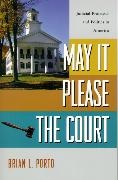Share
Fr. 135.40
Brian L. Porto
May It Please the Court
English · Paperback / Softback
Shipping usually within 3 to 5 weeks
Description
List of contents
(Each chapter contains a Conclusion before the Epilogue.)
Figures.
Preface.
1. Courts and Judges in the Political Process.
Law and Politics: Myth and Reality.
The Political Context of Judging.
Courts in the American Political System.
Links Between Law and Politics.
The Differences Between Law and Politics.
Reconciling Law and Politics.
Conclusion: Law, Politics, and Judicial Decisions.
Epilogue: The Law and Politics of Flag Burning: United States v. Eichman, 496 U.S. 310 (1990).
2. American CourtsñStructures and Procedures.
Federalism and the Judiciary.
State Court Systems.
Introduction.
Trial Courts of Limited Jurisdiction.
Trial Courts of General Jurisdiction.
Intermediate Appellate Courts.
Courts of Last Resort.
The Federal Court System.
Introduction.
Specialized Federal Courts.
U.S. District Courts.
U.S. Courts of Appeals.
U.S. Supreme Court.
Federal Court Administration.
Relations Between State and Federal Courts.
Epilogue: The Roots of Judicial Federalism: Martin v. Hunter's Lessee, 14 U.S. (1 Wheat.) 304 (1816).
3. Lawyers and Lawyering.
Introduction.
A Brief History of the Legal Profession.
The Legal Profession Today.
Entry.
Culture.
Practice.
Challenges.
Epilogue: Client Solicitation and Free Speech: Florida Bar v. Went For It, Inc., 115 S.Ct. 2371 (1995).
4. Judicial Selection and Removal.
Law, Politics, and Judicial Nominations.
Judicial Selection in the States.
Introduction.
Election.
Appointment.
Appointment-and-Election.
Legislative Selection.
Conclusion.
Discipline and Removal of State Judges.
Selection of Federal Judges.
Introduction.
The Lower Federal Courts.
The Supreme Court.
Discipline and Removal of Federal Judges.
Epilogue: Voting Rights and Judicial Elections: Chisom v. Roemer, 501 U.S. 380 (1991).
5. Norm Enforcement: The Criminal Justice Process.
Introduction.
State v. Johnson: Facts.
State v. Johnson: Participants.
The Defendant.
The Defense Attorney.
The Prosecutor.
The Judge.
State v. Johnson: Process.
Pretrial.
Trial.
Epilogue: Dr. Sheppard's Trial: Sheppard v. Maxwell, 384 U.S. 333 (1966).
6. Dispute ResolutionñThe Civil Justice Process.
Introduction.
Peterson v. Big Pine Mountain Ski Corporation: Facts.
Participants.
The Plaintiff.
The Plaintiff's Attorney.
The Defendant.
The Defense Attorney.
The Judge.
Process.
Pretrial.
Trial.
Epilogue: Dr. Gore's Windfall: B.M.W. of North America, Inc. v. Gore, 517 U.S. 559 (1996).
7. Policy MakingñThe Appellate Process.
Introduction.
State v. Johnson on Appeal.
Post-Verdict Motions.
Notice of Appeal.
Briefs.
Oral Argument.
Decision Conference.
Decision.
Peterson On Appeal.
Post-Verdict Motion.
Notice of Appeal.
Briefs.
Oral Argument.
Decision Conference.
Decision.
Epilogue: Open Fields and a “Tumbledown” House: State v. Kirchoff, 156 Vt. 1, 587 A.2d 988 (1991); Pines v. Perssion, 14 Wis.2d 590, 111 N.W.2d 409 (1961).
8. Legal and Political Influences on Judicial Decision Making.
Introduction.
Legal Influences.
Procedural.
Substantive.
Political Influences.
Attitudinal.
Organizational.
Institutional.
Reconciling Legal and Political Perspectives.
Epilogue: The Law and Politics of Abortion: Planned Parenthood of Southeastern Pennsylvania v. Casey, 505 U.S. 833 (1992).
9. The Limits of Judicial Policy Making.
Introduction.
The Debate About Judicial Policy Making.
Overview.
Judicial Restraint v. Judicial Activism.
Constrained Court v. Dynamic Court.
An Assessment of Judicial Policy Making.
Legitimacy.
Capacity.
Impact.
Epilogue: A School System Flunks Out: Rose v. Council for Better Education, Inc., 790 S.W.2d 186 (Ky. 1989).
10. Summary and Conclusion.
Summary.
Conclusion.
Appendix A: Researching The Law.
Appendix B: Documents of Litigation.
Criminal.
Application and Supporting Affidavit for Apartment Search.
Search Warrant.
Indictment.
Motion to Suppress Evidence.
Civil.
Complaint.
Answer.
Summary
This dynamic new judicial process text is a practical, comprehensive, and engaging introduction to our judicial system. May It Please the Court is unique in two important ways: 1) it offers students an insider's view of the courts not found in other texts, and 2) it gives equal attention to the effects of both political and legal influences, respectively, on judicial decisions. Other texts stress the impact of political influences on the judicial process, but understate the impact of legal influences: this text shows that the judicial process operates at the intersection of law and politics, and that it is necessary to understand both law and politics in order to know how courts work. The author, Brian Porto, is a practicing lawyer as well as a political scientist and brings his years of real-world experience to bear on his text. As a result, May It Please the Court offers a realistic view of the courts, including their day-to-day procedures, and it conveys the human drama of criminal and civil litigation, which is often missing in other texts. Actual court cases at the end of each chapter give students an opportunity to think critically, and provide a springboard for class discussion.
Product details
| Authors | Brian L. Porto |
| Publisher | Pearson Academic |
| Languages | English |
| Product format | Paperback / Softback |
| Released | 01.01.2000 |
| EAN | 9780321036834 |
| ISBN | 978-0-321-03683-4 |
| No. of pages | 320 |
| Weight | 420 g |
| Series |
Longman Longman |
| Subject |
Social sciences, law, business
> Law
> General, dictionaries
|
Customer reviews
No reviews have been written for this item yet. Write the first review and be helpful to other users when they decide on a purchase.
Write a review
Thumbs up or thumbs down? Write your own review.

